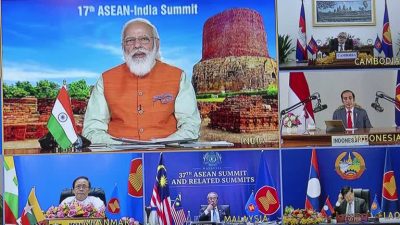Trade
India not ready for RCEP

Author: Nilanjan Ghosh, ORF
On 15 November 2020, 15 nations (the 10 ASEAN countries, Australia, China, Japan, New Zealand and South Korea) signed the Regional Comprehensive Economic Partnership (RCEP). The clamour around India’s decision to walk away from the mega trade deal was loud. But the trading bloc has kept the door open for India to return to the negotiating table.
The economic backdrop to India’s departure is dismal. The nationwide lockdown in response to COVID-19 had a deleterious impact on India’s economy, with GDP contracting by 23.9 per cent in the first quarter and 7.5 per cent in the second. The silver lining is that the second quarter figure was better than expected, but big problems remain. Indian growth over the last three decades has been largely consumption driven, but consumption has been hit by lockdown. Loan moratoriums are unlikely to help much, as only a small proportion of the Indian population have formal sector loans. To boost aggregate demand, disposable incomes need to be stepped up through fiscal measures such as direct tax deductions and targeted direct income transfers.
India’s economic growth was slowing even prior to the pandemic, likely due to a poor combination of structural and business cycle issues. With the pandemic, India’s ambition of achieving aUS$5 trillion economy by 2024 is unattainable, requiring GDP to double with herculean average annual growth rates of 23–24 per cent. The present signs of economic revival are, at most, a result of latent demand carried over from the lockdown and some supply-side measures brought about through expansionary fiscal and monetary policies.
Prime Minister Narendra Modi’s speech in May 2020 laid out a grand vision of restarting the economy and making it more self-reliant. This ‘self-reliance’ is an extension of his earlier ‘Make in India’ idea, and should be interpreted as a means of creating a robust domestic economy through investment and consumption demand.
This is neither import substitution, nor does it preclude foreign investment. But without a congenial business environment, achieving a robust domestic economy is not possible. Hence, Modi emphasised the need to address land, labour, liquidity and laws to create the necessary institutional incentives for kick-starting the languishing economy.
Unfortunately, the vision has hardly been translated into action. Proposed supply-side interventions such as easing credit and certain factor market incentives to micro, small and medium enterprises (MSMEs) are desirable, but there has been little impetus to boost demand. The government’s decision to not have global tenders for procurements up to Rs2 billion (US$27 million) will help insulate MSMEs from global competition but will not alleviate the long-term problems. The National Steel Policy 2017, for instance, identifies long-term problems as being a lack of domestic demand, high input costs and cheap imports from China and ASEAN countries. These are symptoms of the problem not its cause.
Many have expressed that the withdrawal from RCEP is a missed opportunity for India, as the deal would have helped Indian businesses to integrate effectively into regional Asian value chains. RCEP would also enable India to attract greater investment due to preferential access to the growing market of RCEP countries and the flight of capital from China in response to the US–China trade war and the pandemic.
For India to reap these benefits, it needs a competitive business environment. In terms of the ease-of-doing-business index, India lags behind all RCEP countries except Cambodia, Laos and the Philippines. This makes it unlikely that RCEP would be beneficial to either the ‘Make in India’ or the ‘self-reliant India’ visions unless the necessary institutional factor and product market reforms are implemented. These include reforms in a fragmented labour market — despite the recent passage of three bills in 2020 that have their own problems — and taxes, including the consumption tax regime that has a high cost of compliance.
Putting the geopolitical issues involved with the presence of China in the bloc aside, there are also macroeconomic and equity concerns in India over RCEP. According to some estimates, the expected gains for India in GDP, trade and investment through RCEP may be offset by a decline in overall economic well-being, given distributive impacts across the value chain. This indicates a potentially problematic impact of the mega trade deal in an economy that is in a poor position to adopt…
Trade
Self-Reliance and Openness: Core Principles of China’s Third Plenary Session

The Third Plenum communique from the CCP indicates a prioritization of stability and compromise in response to China’s economic challenges. It highlights the concept of Chinese-style modernization and establishes political guidelines for balancing regulation and market forces.
The CCP’s Third Plenum communique signals a focus on stability and compromise in the face of China’s economic challenges. It emphasises Chinese-style modernisation and sets political directions for balancing regulation and market forces. While not as groundbreaking as previous plenums, it acknowledges the importance of market mechanisms and technological self-reliance, aiming to address issues like high youth unemployment and private sector uncertainty. The communique seeks to navigate the complexities of global competition and domestic innovation, potentially reshaping global supply chains and trade dynamics. Overall, it presents a pragmatic blueprint for China’s economic future.
Source : Self-reliance and openness central pillars of China’s Third Plenum | East Asia Forum
Trade
Trade Prevails Over Political Persuasions in China-Germany Relations

China and Germany maintain a strong bilateral relationship, rooted in economic cooperation despite ideological differences. Recent visits and agreements focus on expanding trade and addressing mutual concerns, navigating challenges while nurturing ties.
Evolving Bilateral Ties
China and Germany share a strong bilateral relationship, rooted in history since 1972. This connection has seen moments of cooperation intertwined with periods of tension. German Chancellor Olaf Scholz’s April 2024 visit underscores Germany’s commitment to fostering this partnership, reflecting a mutual interest in maintaining economic ties despite ideological differences.
Economic Pragmatism
As the second and third largest global economies, China and Germany’s economic interdependence is crucial. Germany emerged as China’s primary trading partner in 2023, with trade values reaching €254.4 billion (US$280 billion). In response to global scrutiny, Germany has taken a balanced approach, emphasizing economic stability over political discord. This was evident during Scholz’s prior visit in November 2022, where his diplomatic tone contrasted with broader EU sentiments.
Facing Challenges Together
Despite increasing public skepticism in Germany regarding China’s global influence and human rights issues, both nations continue to seek common ground. Their October 2023 Joint Statement highlights intentions to pursue cooperation in areas like carbon neutrality and open markets. To navigate these complex terrains, Germany can utilize its institutional frameworks to enhance dialogue, while also considering supply chain diversification to reduce dependency on China. The intertwining nature of their economies suggests that, despite challenges, both countries will continue to prioritize their substantial trade relations.
Source : Trade trumps political persuasions in China–Germany relations
Trade
Fixing fragmentation in the settlement of international trade disputes

Fragmentation in global trade due to the lack of development in multilateral trade rules at the WTO has led to an increase in FTAs. The Appellate Body impasse has further exacerbated fragmentation, requiring a multilateral approach for reform.
Fragmentation in Global Trade
Fragmentation in global trade is not new. With the slow development of multilateral trade rules at the World Trade Organization (WTO), governments have turned to free trade agreements (FTAs). As of 2023, almost 600 bilateral and regional trade agreements have been notified to the WTO, leading to growing fragmentation in trade rules, business activities, and international relations. But until recently, trade dispute settlements have predominantly remained within the WTO.
Challenges with WTO Dispute Settlement
The demise of the Appellate Body increased fragmentation in both the interpretation and enforcement of trade law. A small number of WTO Members created the Multi-Party Interim Appeal Arbitration Arrangement (MPIA) as a temporary solution, but in its current form, it cannot properly address fragmentation. Since its creation in 2020, the MPIA has only attracted 26 parties, and its rulings have not been consistent with previous decisions made by the Appellate Body, rendering WTO case law increasingly fragmented.
The Path Forward for Global Trade
Maintaining the integrity and predictability of the global trading system while reducing fragmentation requires restoring the WTO’s authority. At the 12th WTO Ministerial Conference in 2022, governments agreed to re-establish a functional dispute settlement system by 2024. Reaching a consensus will be difficult, and negotiations will take time. A critical mass-based, open plurilateral approach provides a viable alternative way to reform the appellate mechanism, as WTO Members are committed to reforming the dispute settlement system.
Source : Fixing fragmentation in the settlement of international trade disputes






